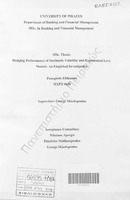Hedging performance of stochastic volatility and exponential levy models: an empirical investigation

Προβολή/
Θεματική επικεφαλίδα
Hedging (Finance) ; Stochastic processes ; Options (Finance) -- Prices -- Mathematical models ; Levy processesΠερίληψη
This thesis examines whether exponential Levy models are providing better hedging results than stochastic volatility models. For this reason we include two stochastic volatility models, Heston and SABR, the first can be considered as benchmark for hedging purposes, since Bakshi et al. (1997) found that the inclusion of jumps in this model does not improve its hedging ability. On the other hand it uses the pure jump process, CGMY. It considers single instrument and two instrument hedging schemes. In single instrument hedging it uses only the underlying as hedging instrument and it applies Delta and minimum variance hedging. It finds that minimum variance improves delta-hedging performance. Also CGMY process is better in minimum variance hedging; in two instruments hedging an option is included in the instrument portfolio. In stochastic volatility models the instrument option is used for hedging against volatility changes. In pure jump models the instrument option is used for hedging against market jumps. For this reason it expands minimum variance strategy so that an option can be used as hedging instilment. It finds that when a second option is used, stochastic volatility models provide better hedging results than CGMY. Thus the hedging of stochastic volatility effects is more important than the hedging of jumps.


